
Welcome to the Trilogy EV300
Training Videos

Trilogy EV300: Setting up S/T mode for NIV

Trilogy EV300: Setting up circuits


Trilogy EV300: window navigation Option 2
for software 1.06.02.00 and above
Includes alarm silence reset and trendsTraining Modules and Presentations

Trilogy EV300: Getting started
The Trilogy EV300: Getting started course is an introduction to basic operations of the device.

Trilogy EV300: Respiratory Mechanics
The Trilogy EV300: Respiratory Mechanics is an introduction to the lung parameters estimation feature included in the EV300
White Papers and Symposiums

Trilogy EV300 and V60 for NIV Benchstudy
This white paper reviews the performance (tidal volume, triggering, pressurization, and synchronization) of the Philips hospital ventilators


ATS 2022 NIV Bench study Symposium Recording
This is a video recording of the Philips sponsored symposium: Hospital NIV support, a comparative bench study with Dr. Belda

Lung Parameters Estimation
This white paper provides a detailed understanding of the lung parameters estimation in the Trilogy EV300.
Calculations Tool

Ventilation Calculations Tool
This ventilation parameters tool provides a quick and easy way to calculate IBW, inspiratory time and I:E ratios
